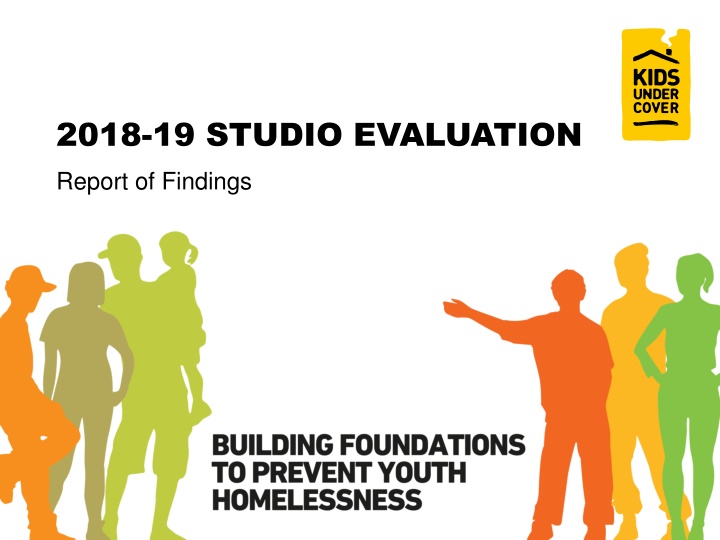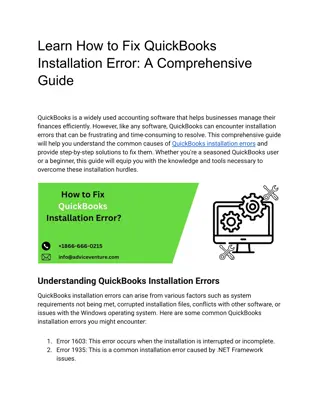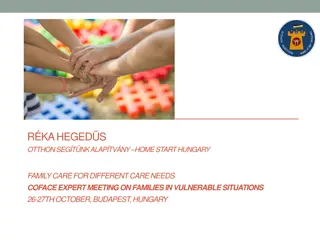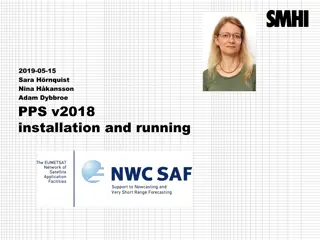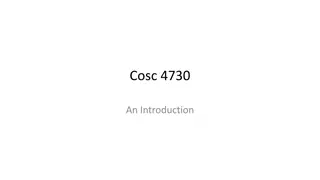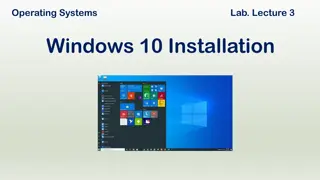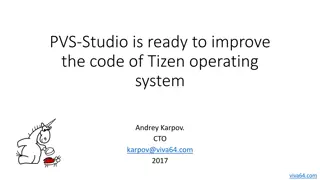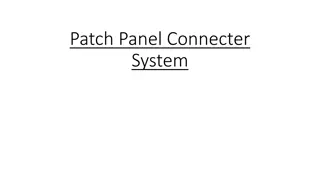Positive Impact of Studio Installation on Young People and Families
Following the installation of studios for young residents, significant improvements were observed in various aspects such as family harmony, reduced conflict, lower risk-taking behaviors, improved school attendance, and enhanced overall well-being. Overcrowding in houses reduced sharply, and families reported better relationships and optimism for the future. The findings indicate a positive transformation in the living conditions and relationships of young people and families post-studio installation.
Download Presentation

Please find below an Image/Link to download the presentation.
The content on the website is provided AS IS for your information and personal use only. It may not be sold, licensed, or shared on other websites without obtaining consent from the author.If you encounter any issues during the download, it is possible that the publisher has removed the file from their server.
You are allowed to download the files provided on this website for personal or commercial use, subject to the condition that they are used lawfully. All files are the property of their respective owners.
The content on the website is provided AS IS for your information and personal use only. It may not be sold, licensed, or shared on other websites without obtaining consent from the author.
E N D
Presentation Transcript
2018-19 STUDIO EVALUATION Report of Findings
SUMMARY Between 2nd 5th September 2019, DBM Consultants interviewed 120 carers of young people who were studio residents in 2018-19. It was very clear that, after the studio was installed, the young person was far less likely to be away from home with the carer not knowing where they were. There was also a noticeable positive impact on the well-being of the young person and family in many areas such as the mood of the young person and crowding in the house. IMPACT OF STUDIO: BEFORE AND AFTER Family s ability to get along Before: 41% After: 97% Crowding in the house General mood in young person Before: 18% After: 94% Before: 93% After: 10% Meet required school attendance Before: 74% Conflict in the house Before: 78% After: 97% After: 27% Level of achievement of young person at school Before: 44% Risk-taking behaviours in young person Before: 31% After: 4% After: 89% Optimism about young person s future Before: 43% Time spent away from property Before: 35% After: 6% After: 89%
OVERCROWDING DRAMATICALLY DOWN HOW CROWDED IS HOUSE? Overcrowding of houses has reduced sharply following the introduction of the studio. Severely overcrowded 40% 3% Just one in ten houses (10%) now report being severely or very over-crowded, whereas beforehand more than nine in ten (93%) were. 53% Very overcrowded 7% A little 6% Some 3% of the houses are still thought to be severely overcrowded, but this is down from 40% before. overcrowded 43% Not overcrowded at all 2% 47% Before the Studio After the Studio SINCE THE STUDIO Severely/very overcrowded houses declined from 93% to 10% Base: All (n=120) Severely/very overcrowded Years in studio Total 93% 10% 2 or less >2 to <5 5+ Before After 97% 93% 80% 10% 10% 10% Base: 2 or less (n=58), >2 - <5 (n=42), 5+ (n=20); caution urged throughout when analysing these results
FAR LESS REGULAR CONFLICT NOW HOW OFTEN IS THERE CONFLICT IN THE HOUSE? Conflict in the house - if there is any - becomes more likely to occur fortnightly/monthly than weekly or more frequently after the studio. 55% Often conflict, like daily or almost daily 6% Before the studio, eight in ten households (78%) were subject to conflict at least weekly, with most of these (55% overall) reporting some sort of episode almost daily or even more regularly than that. 23% 21% Occasionally conflict, like weekly A little bit of conflict, like fortnightly or monthly 15% 43% Now just 6% of households report daily conflict. 8% Never any conflict 31% Before the Studio After the Studio SINCE THE STUDIO Incidence of frequent conflict has declined from 55% to 6% Base: All (n=120) Often/occasionally conflict Years in studio Total 78% 27% 2 or less >2 to <5 5+ Before After 76% 79% 80% 21% 33% 30%
ALMOST ALL FAMILIES GET ALONG WELL NOW HOW WOULD YOU RATE THE FAMILY S ABILITY TO GET ALONG TOGETHER? The family gets on very badly The number of families not getting on well has almost reached zero now. Before the studio, six in ten families (59%) were not getting on well together, but that number declines to just 3% post-studio. 18% 0% Close to all families (97%) now report that they get on quite or very well together, more than doubling the number who did before (41%). The family doesn t get on too well 41% 3% The family gets on quite well 36% 55% The family all gets on very well 5% 42% Before the Studio After the Studio SINCE THE STUDIO Incidence of family getting on quite or very well has increased from 41% to 97% Base: All (n=120) Family gets on very/quite well Years in studio Total 41% 97% 2 or less >2 to <5 5+ Before After 50% 31% 35% 97% 98% 95%
LESS TIME AWAY FROM HOME UNACCOUNTED FOR HOW MUCH TIME DOES THE YOUNG PERSON SPEND AWAY FROM THE PROPERTY? Incidence of the young person being away from home, where nobody knows their whereabouts, declines dramatically after the introduction of the studio. A lot of time away from the property 17% Before the studio was built, one in six of the young people (17%) were away from the property a lot, without the carer knowing where they were, with a similar number (18%) away fairly often. Now, just 6% are notably away without their carer s knowledge of their whereabouts. 1% A fair amount of time away from the property 18% 5% Hardly any time away from the property 38% 62% They never leave the property 27% 33% Before the Studio After the Studio Base: All (n=120) SINCE THE STUDIO Decline in number away from the property a lot/fair amount of time from 35% to6% A lot/fair amount of time away from the property Years in studio Total 35% 6% 2 or less >2 to <5 5+ Before After 28% 48% 30% 5% 5% 10%
RISK-TAKING DRASTICALLY REDUCED HOW OFTEN DOES THE YOUNG PERSON TAKE PART IN RISK-TAKING BEHAVIOURS? The number of young people taking part in risky behaviour often or occasionally has fallen to virtually none. Just 4% partake in risk-taking behaviours, such as drug and alcohol use or risky online activity occasionally or often, down from 31% before the studio was built. Often take part in risky behaviours 15% 1% Occasionally take part in risky behaviours 16% 3% Following the introduction of the studio, the proportion that never take part in risky behaviour has moved up from 47% to 69%. Sometimes take part in risky behaviours 12% 18% Never take part in risky behaviours 47% 69% Not sure about their risk-taking behaviours Before the Studio 11% 9% After the Studio Base: All (n=120) SINCE THE STUDIO Decline in incidence of frequent/occasional risk-taking behaviours from 31% to 4% Often/occasionally take part in risk-taking behaviours Years in studio Total 31% 4% 2 or less >2 to <5 5+ Before After 28% 38% 25% 3% 5% 5%
HUGE IMPROVEMENT IN MOOD HOW WOULD YOU DESCRIBE THE GENERAL MOOD OF THE YOUNG PERSON? The general demeanour of the young people has improved greatly since the advent of the studio. Previously a third of them (33%) were never happy, and a further half (50%) only occasionally happy. Now just 6% are occasionally or never happy, with the remaining 94% usually or always happy (up from 18%). The level of happiness continues to be a little lower among those who have been in the studio between 2 5 years. 33% Never happy 1% 50% Occasionally happy 5% 13% Usually happy 48% Always or nearly always happy 4% 47% Before the Studio After the Studio SINCE THE STUDIO Incidence of young person being usually/always happy increased from 18% to 94% Base: All (n=120) Always/nearly always/usually happy Years in studio Total 18% 94% 2 or less >2 to <5 5+ Before After 21% 10% 25% 97% 88% 100%
MOST NOW MEETING REQUIRED LEVEL OF SCHOOL ATTENDANCE HOW OFTEN IS THE YOUNG PERSON GOING TO SCHOOL/ TAFE/UNI? Attendance at learning facilities has increased substantially since the studio was introduced to the household. The proportion of young people meeting the required level of attendance has now increased from 48% to 85%, with rare or non-attendance down to just 1%. Not going to school/TAFE/uni at all 7% 0% Rarely meeting the required level of attendance 15% 1% Not always meeting the required level of attendance 26% 12% Meeting the required level of attendance 48% SINCE THE STUDIO Proportion not going or rarely meeting the required level of attendance declined from 22% to1% 85% 4% 1% Don't know Before the Studio After the Studio Base: Currently attending school/TAFE/university (n=73)
EDUCATION PERFORMANCE EDUCATION PERFORMANCE SHOWING MARKED IMPROVEMENT SHOWING MARKED IMPROVEMENT The performance of young people at their education establishment has improved greatly post-studio. HOW WOULD YOU RATE LEVEL OF ACHIEVE- MENT OF YOUNG PERSON GOING TO SCHOOL/TAFE/UNI? The proportion doing very or quite poorly has declined from 48% to 8%, while the number performing very well has increased almost five-fold from 10% to 47%. Doing very poorly at school/TAFE/uni 19% 3% Doing quite poorly at school/TAFE/uni 29% 6% Doing quite well at school/TAFE/uni 34% 43% Doing very well at school/TAFE/uni 10% SINCE THE STUDIO Noticeable increase in incidence of young people doing quite/very well educationally, from 44% to 89% 47% 8% 3% Don't know Before the Studio After the Studio Base: Currently attending school/TAFE/university (n=73)
FINANCIAL EFFECTS OF SCHOLARSHIPS IMPROVING HOW MUCH BETTER/ WORSE SINCE THE STUDIO? Not only are young people and their families clearly benefiting from Kids Under Cover scholarships, but the financial aspects of these are even more noticeable this year than in previous years. Attendance 39% 14% 39% While attendance has improved for more than half (53% much or a little better), their ability to purchase the necessary school or course requirements is much better for nine in ten (92%), compared with 68% last year. Hence, nearly two-thirds (64%) claim their level of financial stress associated with education costs, is much better, up from 50% last year. Ability to purchase necessary school or course requirements 92% 6% 3% Financial stress 64% 25% 8% Much better The same A little better Worse Much better since studio Base: Have/had scholarship (n=36) 2017 2018 2019 Attendance 46% 40% 39% Ability to purchase the necessary school or course requirements 81% 68% 92% Financial stress 59% 50% 64%
HUGE INCREASE IN OPTIMISM LOOKING FORWARD HOW OPTIMISTIC ABOUT THE YOUNG PERSON S FUTURE? The vast majority of carers are now at least somewhat optimistic about the future of their charge (89%). Very pessimistic about their future 18% Indeed, two-thirds of them (64%) are very optimistic about the young person s future, up from just 15% before the introduction of the studio. 2% Somewhat pessimistic about their future Neither optimistic nor pessimistic/don't know 19% 3% 14% 6% Pessimism has declined sharply too, with only 2% now very pessimistic about the young person s future, compared to 18% before. Somewhat optimistic about their future 28% 25% Very optimistic about their future 15% 64% SINCE THE STUDIO Optimism about the future for the young person has increased from 43% to 89% Before the Studio After the Studio Base: All (n=120) Very/somewhat optimistic Years in studio Total 43% 89% 2 or less >2 to <5 5+ Before After 41% 38% 60% 91% 88% 85%
